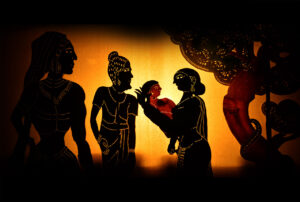
The cinema has always been an excellent source of entertainment for humans, whether it is the 90s movie Andaz Apna Apna or Bhool Bhulaiyaa of the 2000s. Even so, there are other sources of entertainment, and in ancient times storytelling was done through plays and shows. One of the finest examples of this is Shadow Theatre.
Shadow theatre or shadow puppet theatre is an ancient form of storytelling and entertainment, and as its name suggests, it was performed using flat and movable shadow puppets. With the help of a translucent screen and a light, puppets are used to create a story. Shadow puppet theatre has an uncertain origin, but some sources attribute it to China or India in the first millennium BCE. Scholars supporting the Indian origin theory reference it in the ancient Tamil classic ‘Silappadikaram’, a Tamil classic written around the 1st or 2nd century B.C.
The cut-out figures were made of leather and were meticulously crafted, ensuring that their shadow created an illusion of their attire, accessories and other accompanying items. Generally, these shows are performed near or at Hindu temples at night, mostly on the occasion of temple festivals. Shadow theatre is a prevalent practice in many South Asian and Southeast Asian countries, with various forms of shadow puppets or puppetry traditions existing in different regions. These include Tholu Bommalata from Andhra Pradesh, Togalu Gombeyatta from Karnataka, Tholpavakoothu from Kerala, Ravan Chhaya from Orissa, Thol Bommalattam from Tamil Nadu, and Chamadyache Bahulya from Maharashtra. Earlier shadow plays were prevalent in both Central and Northern India but later became confined to southern regions.
Chamadyache Bahulya, or Charma bahuli Natya, is mainly practiced in the region of southwest India, particularly in the Sindhudurg district of Maharashtra. The word ‘bahulya’ denotes ‘figure’, while the word ‘chamadyache’ or ‘chamadyacha’ denotes ‘leather’, and means skin doll in Marathi. All Shadow actors, puppets and picture presenters are collectively known as “Baulekar” which is derived from the Marathi word “bahuli” meaning “puppet”.In total, sixty-five figures would be used, each measuring between 11 and 35 cm. They are crafted by treating buffalo, goat or deer leather to create a translucent effect. They are coloured using vegetable-based pigments and are not pierced, but sometimes they have a moving hand or joint. Apart from this, a bamboo stick or split is utilized to hold the puppets, which are then pushed against a screen with a light source positioned behind them. Generally, the Paithani style (named after a town in Aurangabad district of Maharashtra) is used for decoration while the characters in the play were often adorned with Mughal-like mustaches and beards, along with baggy pants. These decorations and attire were commonly associated with kings and gods in theatrical performances.
The play starts with a purvaranga or prelude where the Hindu deities Ganesha and Saraswati are invoked. This is followed by a dance performance at the court of Indra. Behind the white cloth screen, puppeteers, singers and musicians perform. This group includes a puppeteer, a helper, and two musicians or singers, in which one plays dholak and pakhavaj (two-headed skinned drums), while the other plays ektara and cymbals. The main themes presented are scenes from the famous epic Ramayana from Panchavati to Ravanvadh and Mahabharata etc.
Chamadyache Bahulya was practiced by men of the Thakar Adivasi community, who chiefly reside or their centre lies in the Gudiwadi area of Pinguli village. This village is located 16 Kilometers to the north of Sawantwadi town in the Kudal Taluka within the Sindhudurg district of Maharashtra. Today they are found in different places in Maharashtra. It is believed that the Thakras, who are specialists in various performing arts, were originally from Rajasthan and, in the seventeenth century, came to Maharashtra under Shivaji Bhonsle I who gave them the area of Pinguli and Kudal. Thakars gave up their nomadic lifestyle and started doing agriculture and now are also practicing fishing as well. Earlier, they used to work as spies, but later they came to Sindhudurg under the assistance of Sawantwadi rulers(1627-1947) and became performing artists for palaces and village temples.
Presently, the community is facing migration to other regions of Maharashtra such as Kolhapur, Mumbai and Pune in search of better opportunities for work and education. The lack of a devoted audience, along with the low incentives given by the government, is also a reason for the slow death of such forms of entertainment. Also, plays in local languages do not gain popularity. While ‘Occupational mobility’ is seen amongst the poor puppeteers, the reputed ones would not lose much due to their means and connections. The loss of knowledge about making puppets is also rising, causing certain problems.Chamadyache Bahulya has been handed down through generations in the family of the late Narayan Maske, and the current performer is Shri Ghanashyam Maske, his successor. While institutions like ‘Sangeet Natak Akademi’ are helping artists like Ganpat Sakharam Masge and Parshuram Vishram Gangavane restore this tradition. A museum dedicated to preserving and showcasing the artistic tradition of the Thakar community has been established in Pinguli by Gangavane(received the Padma Shri award in 2021) and is named ‘Thakar Adivasi kala Angan’ or Courtyard of Crafts. While Koodiyattam, a traditional regional form of theatre is now officially being identified by UNESCO as a masterpiece of the Oral and Intangible Heritage of Humanity.
To preserve our traditions, we need strong support from the government, along with raising public awareness through cultural media and institutions. We should establish special institutions to teach traditional art forms and pass on these essential skills to children. Additionally, creating online platforms and portals to showcase the talent of these artists can help in safeguarding our culture and society.

Sanskriti Pundir
Sanskriti Pundir is currently pursuing a Bachelor's degree in History Honours from Indraprastha College for Women. She is determined and is also a budding writer who actively seeks opportunities to improve her writing skills.

